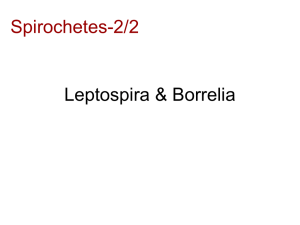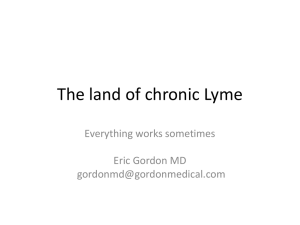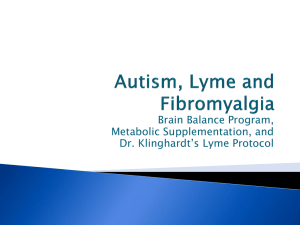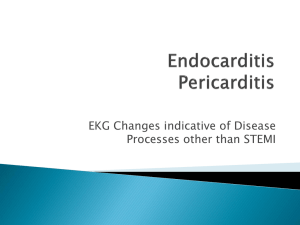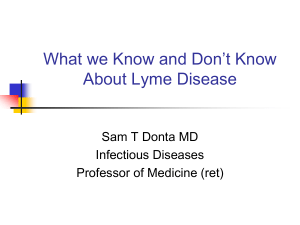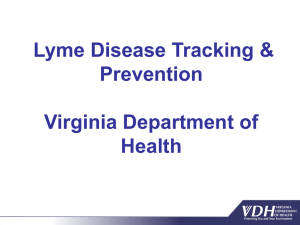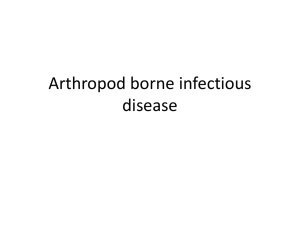Neurologic Manifestations. Dr. Pietrucha
advertisement
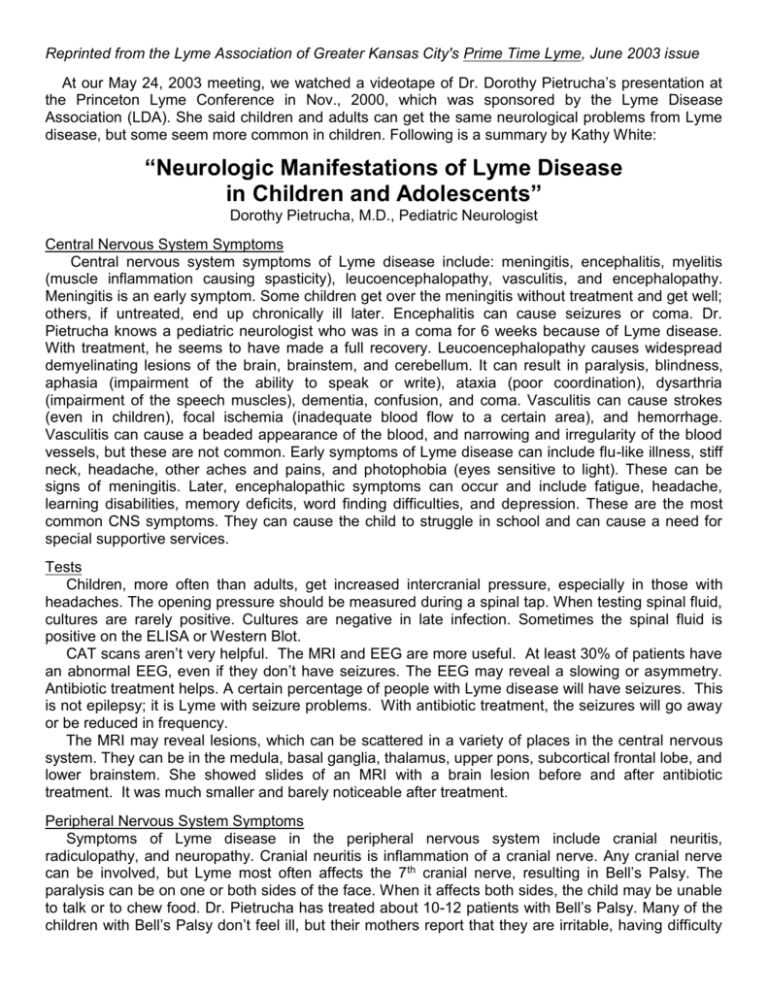
Reprinted from the Lyme Association of Greater Kansas City's Prime Time Lyme, June 2003 issue At our May 24, 2003 meeting, we watched a videotape of Dr. Dorothy Pietrucha’s presentation at the Princeton Lyme Conference in Nov., 2000, which was sponsored by the Lyme Disease Association (LDA). She said children and adults can get the same neurological problems from Lyme disease, but some seem more common in children. Following is a summary by Kathy White: “Neurologic Manifestations of Lyme Disease in Children and Adolescents” Dorothy Pietrucha, M.D., Pediatric Neurologist Central Nervous System Symptoms Central nervous system symptoms of Lyme disease include: meningitis, encephalitis, myelitis (muscle inflammation causing spasticity), leucoencephalopathy, vasculitis, and encephalopathy. Meningitis is an early symptom. Some children get over the meningitis without treatment and get well; others, if untreated, end up chronically ill later. Encephalitis can cause seizures or coma. Dr. Pietrucha knows a pediatric neurologist who was in a coma for 6 weeks because of Lyme disease. With treatment, he seems to have made a full recovery. Leucoencephalopathy causes widespread demyelinating lesions of the brain, brainstem, and cerebellum. It can result in paralysis, blindness, aphasia (impairment of the ability to speak or write), ataxia (poor coordination), dysarthria (impairment of the speech muscles), dementia, confusion, and coma. Vasculitis can cause strokes (even in children), focal ischemia (inadequate blood flow to a certain area), and hemorrhage. Vasculitis can cause a beaded appearance of the blood, and narrowing and irregularity of the blood vessels, but these are not common. Early symptoms of Lyme disease can include flu-like illness, stiff neck, headache, other aches and pains, and photophobia (eyes sensitive to light). These can be signs of meningitis. Later, encephalopathic symptoms can occur and include fatigue, headache, learning disabilities, memory deficits, word finding difficulties, and depression. These are the most common CNS symptoms. They can cause the child to struggle in school and can cause a need for special supportive services. Tests Children, more often than adults, get increased intercranial pressure, especially in those with headaches. The opening pressure should be measured during a spinal tap. When testing spinal fluid, cultures are rarely positive. Cultures are negative in late infection. Sometimes the spinal fluid is positive on the ELISA or Western Blot. CAT scans aren’t very helpful. The MRI and EEG are more useful. At least 30% of patients have an abnormal EEG, even if they don’t have seizures. The EEG may reveal a slowing or asymmetry. Antibiotic treatment helps. A certain percentage of people with Lyme disease will have seizures. This is not epilepsy; it is Lyme with seizure problems. With antibiotic treatment, the seizures will go away or be reduced in frequency. The MRI may reveal lesions, which can be scattered in a variety of places in the central nervous system. They can be in the medula, basal ganglia, thalamus, upper pons, subcortical frontal lobe, and lower brainstem. She showed slides of an MRI with a brain lesion before and after antibiotic treatment. It was much smaller and barely noticeable after treatment. Peripheral Nervous System Symptoms Symptoms of Lyme disease in the peripheral nervous system include cranial neuritis, radiculopathy, and neuropathy. Cranial neuritis is inflammation of a cranial nerve. Any cranial nerve can be involved, but Lyme most often affects the 7th cranial nerve, resulting in Bell’s Palsy. The paralysis can be on one or both sides of the face. When it affects both sides, the child may be unable to talk or to chew food. Dr. Pietrucha has treated about 10-12 patients with Bell’s Palsy. Many of the children with Bell’s Palsy don’t feel ill, but their mothers report that they are irritable, having difficulty in school, or having sleep problems. Other children with Bell’s Palsy have a stiff neck, and their eyes are very sensitive to light. Bell’s Palsy is sometimes treated with steroids. This can make the Lyme disease worse, especially if the child is not also receiving antibiotics. Radiculopathy and neuropathy seem more common in adults than children. Adults are more likely to be bothered by and to report numbness and tingling. Children can get myositis (muscle inflammation) and myalgia (muscle pain). There can be actual changes in the muscles. Children may have knee pain, back pain, crushing chest pain, heart palpitations, and pain in the gastro-intestinal tract. There may be nothing wrong with the digestive system; stomach pain can be caused by the nerves. Or, Lyme spirochetes can be found in the GI tract and cause pain even with very little inflammation. Children can get aching feet, and sore skin which can hurt when touched. Patient Stories One boy developed Bell’s Palsy on the right side of his face and had a mild headache. A year before, he had lost the hearing in his right ear, and was given a CAT scan, which didn’t show any problems. Now that he had Bell’s Palsy, he was given an MRI, which revealed a brain tumor. “We can’t assume that every Bell’s is Lyme,” Dr. Pietrucha cautioned. Another child got Lyme disease with heart problems, carditis and palpitations. He was cured with antibiotics. However, he still had neurological problems which were difficult to diagnose. It was discovered that, in addition to Lyme, he also had a brain tumor unrelated to the Lyme. Another boy had a headache, malaise, weight loss, arthralgia (joint pain), and palpitations, and his right shoulder drooped. He went from doctor to doctor and was told that he was fine and just didn’t want to go to school. After 8 months, he woke up with Bell’s Palsy. Then he was diagnosed with Lyme disease, was treated, and has recovered. Another boy had bilateral Bell’s Palsy. He was unable to talk or chew food. He started antibiotic treatment for Lyme just 2 or 3 weeks after he became ill, and he recovered. One girl had her right foot drop, and she was dragging her foot. She couldn’t bend her ankle, and she told the doctor she couldn’t see out of her left eye. Her vision was tested. Her sight was almost gone in the left eye from optic neuritis, and she could only see 20/200 in the right eye because of papilledema (swelling of the optic nerve). She was treated for Lyme disease with antibiotics. She was able to bend her ankle just 72 hours after treatment began. Her vision eventually returned to 20/20. A 13-year-old boy got a tick bite while camping. He became ill with flu-like symptoms and a stiff neck. He went to the doctor with a headache and dizziness. He had 6 th cranial nerve palsy (causing the eye to deviate outward and result in double vision), and bilateral papilledema (swelling of the optic nerve in both eyes). He recovered with antibiotic treatment. A 5-year-old boy had been ill for 2 years, after a tick bite. He had been tired and weak and had fevers, abdominal pain, and joint aches and pains. He was ataxic (had poor coordination) and needed help to walk. He recovered 2 months after beginning antibiotic treatment and was able to walk and climb stairs. Then he started getting worse. An MRI showed many lesions, and he developed seizures, learning disabilities, ataxia, and dysarthria (poor speech because of muscle problems). He is in a wheelchair and is not responding to treatment. A girl with Lyme disease became progressively weaker with symptoms similar to Guillain-Barre syndrome. She later developed papilledema. She recovered with antibiotic treatment. A teen-age girl had abdominal pain caused by radiculitis (an inflamed nerve). There was nothing wrong with her stomach. She got better with treatment for Lyme disease. Her sister also had Lyme disease. The sister experienced chilliness and myalgias and didn’t improve with treatment. A girl had papilledema, and she was seeing double because of 6 th cranial nerve palsy. She had no headache or other Lyme symptoms and felt well. An opthalmologist diagnosed her with Lyme disease. She recovered after antibiotic treatment. Preschool-aged children with Lyme disease may suddenly develop a personality change and become irritable and depressed, constantly fussy. One very young child was not eating well and had a diaper rash that wouldn’t heal despite all efforts. The child was treated with antibiotics and recovered. The diaper rash went away and never came back. It was really a Lyme rash.


